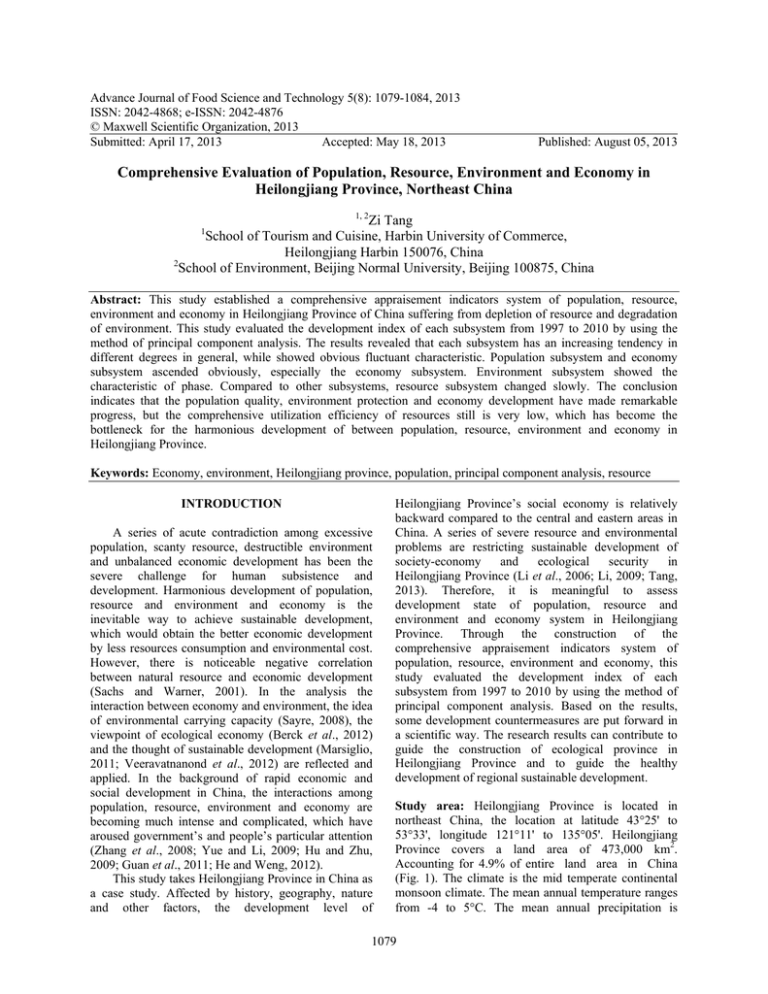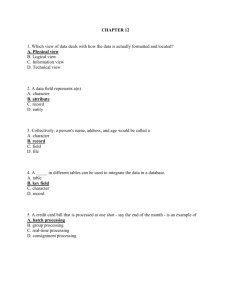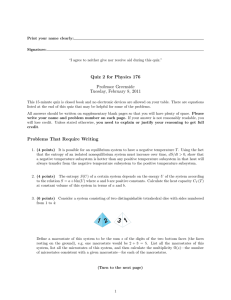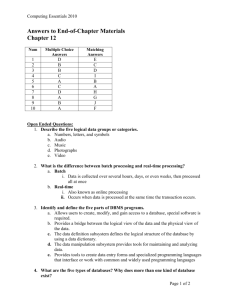Advance Journal of Food Science and Technology 5(8): 1079-1084, 2013
advertisement

Advance Journal of Food Science and Technology 5(8): 1079-1084, 2013 ISSN: 2042-4868; e-ISSN: 2042-4876 © Maxwell Scientific Organization, 2013 Submitted: April 17, 2013 Accepted: May 18, 2013 Published: August 05, 2013 Comprehensive Evaluation of Population, Resource, Environment and Economy in Heilongjiang Province, Northeast China 1, 2 Zi Tang School of Tourism and Cuisine, Harbin University of Commerce, Heilongjiang Harbin 150076, China 2 School of Environment, Beijing Normal University, Beijing 100875, China 1 Abstract: This study established a comprehensive appraisement indicators system of population, resource, environment and economy in Heilongjiang Province of China suffering from depletion of resource and degradation of environment. This study evaluated the development index of each subsystem from 1997 to 2010 by using the method of principal component analysis. The results revealed that each subsystem has an increasing tendency in different degrees in general, while showed obvious fluctuant characteristic. Population subsystem and economy subsystem ascended obviously, especially the economy subsystem. Environment subsystem showed the characteristic of phase. Compared to other subsystems, resource subsystem changed slowly. The conclusion indicates that the population quality, environment protection and economy development have made remarkable progress, but the comprehensive utilization efficiency of resources still is very low, which has become the bottleneck for the harmonious development of between population, resource, environment and economy in Heilongjiang Province. Keywords: Economy, environment, Heilongjiang province, population, principal component analysis, resource INTRODUCTION A series of acute contradiction among excessive population, scanty resource, destructible environment and unbalanced economic development has been the severe challenge for human subsistence and development. Harmonious development of population, resource and environment and economy is the inevitable way to achieve sustainable development, which would obtain the better economic development by less resources consumption and environmental cost. However, there is noticeable negative correlation between natural resource and economic development (Sachs and Warner, 2001). In the analysis the interaction between economy and environment, the idea of environmental carrying capacity (Sayre, 2008), the viewpoint of ecological economy (Berck et al., 2012) and the thought of sustainable development (Marsiglio, 2011; Veeravatnanond et al., 2012) are reflected and applied. In the background of rapid economic and social development in China, the interactions among population, resource, environment and economy are becoming much intense and complicated, which have aroused government’s and people’s particular attention (Zhang et al., 2008; Yue and Li, 2009; Hu and Zhu, 2009; Guan et al., 2011; He and Weng, 2012). This study takes Heilongjiang Province in China as a case study. Affected by history, geography, nature and other factors, the development level of Heilongjiang Province’s social economy is relatively backward compared to the central and eastern areas in China. A series of severe resource and environmental problems are restricting sustainable development of society-economy and ecological security in Heilongjiang Province (Li et al., 2006; Li, 2009; Tang, 2013). Therefore, it is meaningful to assess development state of population, resource and environment and economy system in Heilongjiang Province. Through the construction of the comprehensive appraisement indicators system of population, resource, environment and economy, this study evaluated the development index of each subsystem from 1997 to 2010 by using the method of principal component analysis. Based on the results, some development countermeasures are put forward in a scientific way. The research results can contribute to guide the construction of ecological province in Heilongjiang Province and to guide the healthy development of regional sustainable development. Study area: Heilongjiang Province is located in northeast China, the location at latitude 43°25' to 53°33', longitude 121°11' to 135°05'. Heilongjiang Province covers a land area of 473,000 km2. Accounting for 4.9% of entire land area in China (Fig. 1). The climate is the mid temperate continental monsoon climate. The mean annual temperature ranges from -4 to 5°C. The mean annual precipitation is 1079 Adv. J. Food Sci. Technol., 5(8): 1079-1084, 2013 Fig. 1: The location of Heilongjiang province in China 400-650 mm, concentrated mostly in the summer season. The frost-free period is 100-160 days and accumulated temperature (≥10°C) is 2000-3000°C. The topography is higher in the northwestern, northern and southeastern hills and lower in the northeastern and southwestern plains. Plains areas account for 37% of the land. The population is 38,334,000 in 2010, accounting for the national total population 2.86%. Heilongjiang Province is rich in resources, where cultivated land, forest, oil and coal resources are tops in the forefront of the country. Due to the complexity of the province's geographical environment and natural conditions, some areas are facing challenges from resources and environment pressures. Data source: According to the indicators system shown in Table 1, the original data utilized in the analyzing process from 1997 to 2010 are derived from the corresponding Heilongjiang Statistics Yearbook (19982011) (Statistics Bureau of Heilongjiang Province, 1998-2011). There are 490 samples. All the statistical analyses are performed using SPSS statistical software, version 20. Data standardization: In order to eliminate the noise interference caused by different dimensions of the indicators, the original data need to be dealt with. This study standardizes the original data with the following method (Z-score) (Tang, 2013): METHODOLOGY ZX ij = Establishment of index system: On the basis of the principles of typicality, integrality and feasibility, this study establishes the comprehensive appraisement indicators system of population, resource, environment and economy in Heilongjiang Province (Table 1). Finally, 35 factors are chosen to analyze the coupling status among population, resource, environment and economy in Heilongjiang Province (Table 1). X ij − X ij (1) S ij where, ZX ij = The non dimensional value processed by standardization X ij = The value of raw data 𝑋𝑋� ij = The average value of raw data S ij = The standard deviation value of raw data 1080 R Adv. J. Food Sci. Technol., 5(8): 1079-1084, 2013 Table 1: The comprehensive appraisement indicators system of population, resource, environment and economy in Heilongjiang province System Index Factor Population (Z 1 ) Scale (Y 1 ) Total population (10000 persons, X 1 ), density of population (person/km2, X 2 ), natural growth rate (%, X 3 ) Structure (Y 2 ) Proportion of urban population (%, X 4 ), Proportion of employed persons (%, X 5 ), dependency rate (%, X 6 ) Quality (Y 3 ) University and college students per 10000 population (person, X 7 ), number of health institutions beds per 10000 persons (unit, X 8 ) Resource (Z 2 ) Total and per capita data (Y 4 ) Total energy production (10000 tons of SCE, X 9 ), per capita energy production (tons of SCE, X 10 ), per capita water volume (cu.m, X 11 ), per capita cultivated area (ha, X 12 ), per capita stock volume of the forest (cu.m, X 13 ) Efficiency (Y 5 ) Elasticity ratio of energy consumption (X 14 ), clean energy composition (%, X 15 ), energy consumption unit GDP (tons of SCE/10000 Yuan, X 16 ) Environment Ecological condition (Y 6 ) Forest-coverage rate (%, X 17 ), per capita public green areas (m2, X 18 ) (Z 3 ) Pollution discharge (Y 7 ) Volume of industrial waste water discharged (10000 tons, X 19 ), volume of waste gas emission (100 million cu.m, X 20 ), volume of industrial solid wastes produced (10000 tons, X 21 ) Pollution treatment (Y 8 ) Percentage of industrial waste water up to the discharge standards (%, X 22 ), volume of industrial solid wastes utilized (10000 tons, X 23 ), total funds of pollution treatment (10000 Yuan, X 24 ) Economy (Z 4 ) Level (Y 9 ) Gross domestic product (100 million Yuan, X 25 ), per capita GDP (Yuan, X 26 ), per capita retail sales of consumer goods (Yuan, X 27 ), per capital annual net income of rural residents (Yuan, X 28 ), per capital annual disposable income of urban residents (Yuan, X 29 ) Structure (Y 10 ) Proportion of primary industry (%, X 30 ), proportion of secondary industry (%, X 31 ), proportion of tertiary industry (%, X 32 ) Benefit (Y 11 ) Overall labor productivity (Yuan/person, X 33 ) Impetus (Y 12 ) Proportion of investment in fixed assets in GDP (%, X 34 ), per capita foreign capital actually used (USD, X 35 ) i j = 1997, 1998, …, 2010 = 1, 2, …, 35 integrated development of environment and economy. Principle component analysis: Principal Component Analysis (PCA) is a multivariate analysis method that can reduce data dimensionality. Compared with other methods, the PCA method is objectively reasonable and widely applicable. The steps of PCA: standard the raw data and then calculate the correlation matrix of the sample data, next calculate it’s the eigenvectors, eigenvalues and the contribution rate, at last select the principal components. Be noted that, the first few principal components can more fully explain the information of raw data that the eigenvalues are greater than 1 or close to 1 and the cumulative contribution rate of variances reach to over 85%. The purpose of the rotation is to transform the initial matrix into one that is easier to interpret, which attempts to minimize the number of subsystems that have high loadings on a factor (Guan and Tang, 2005). In this study, PCA is presented to reduce dimension of population subsystem (Z 1 ), resource subsystem (Z 2 ), environment subsystem (Z 3 ) and economy subsystem (Z 4 ). Varimax orthogonal rotation (Varimax) is selected, then rotated component matrix, eigenvalues, contribution rate of variance, cumulative contribution rate of variance and component score coefficient matrix are obtained. Then inserting the standardization data of various subsystems in component score coefficient matrix to carry on the calculation, the study works out the synthesized score (∑F) and ∑F is taken as the comprehensive assessment value of the four groups and also is the index of population, resource, RESULTS The comprehensive scores of each subsystem: Taking population subsystem as an example, PCA is used to draw the variance contribution and score coefficient matrix by virtue of SPSS statistical software (Table 23). The results from PCA show that when the number of principal components is 3, the cumulative variance explained is 95.590%, which means 3 principal components can explain 95.590% of the total information reflected by the 8 population parameters. Then the population comprehensive score equation (∑FZ i1 ) is built up with the score coefficient matrix and variance contribution. Standardizing data of population subsystem are substituted in this equation to calculate the comprehensive scores of population subsystem for all years 1997-2010. The higher the value, it is shown that the system integration condition is the better. In a similar way, this study calculates the variance contribution, the score coefficient matrix and the comprehensive scores of resource, environment and economy subsystem. The calculated results Table 4-10 and Fig. 2: The comprehensive scores of population subsystem: ∑FZ i1 = 0.440 (0.301 ZX i1 + 0.301 ZX i2 - 0.324 ZX i3 0.141 ZX i4 - 0.030 ZX i5 + 0.042 ZX i6 + 0.154 ZX i7 0.043 ZX i8 ) + 0.381 (-0.060 ZX i1 - 0.059 ZX i2 + 0.115 ZX i3 + 0.403 ZX i4 + 0.294 ZX i5 + 0.164 ZX i6 + 0.122 ZX i7 + 0.363 ZX i8 ) + 0.135 (0.022 ZX i1 + 0.025 ZX i2 - 1081 Adv. J. Food Sci. Technol., 5(8): 1079-1084, 2013 Table 2: Total variance explained of population subsystem Component 1 2 ZX i1 0.974 0.177 ZX i2 0.974 0.179 ZX i3 -0.983 -0.030 ZX i4 -0.036 0.966 ZX i5 0.285 0.897 ZX i6 -0.062 -0.209 ZX i7 0.720 0.609 ZX i8 0.226 0.910 Eigen values 3.521 3.045 % of variance 44.010 38.064 Cumulative % 44.010 82.075 3 -0.053 -0.051 0.007 -0.117 -0.261 0.972 -0.216 -0.044 1.081 13.515 95.590 Table 3: Component score coefficient matrix of population subsystem Component 1 2 3 ZX i1 0.301 -0.060 0.022 ZX i2 0.301 -0.059 0.025 ZX i3 -0.324 0.115 -0.036 ZX i4 -0.141 0.403 0.116 ZX i5 -0.030 0.294 -0.051 ZX i6 0.042 0.164 1.027 ZX i7 0.154 0.122 -0.059 ZX i8 -0.043 0.363 0.192 Table 4: Total variance explained of resource subsystem Component 1 2 3 ZX i9 0.153 0.945 0.249 ZX i10 0.183 0.941 0.199 ZX i11 -0.034 0.177 -0.006 ZX i12 0.911 0.348 0.105 ZX i13 0.890 0.142 -0.046 ZX i14 0.217 0.134 0.901 ZX i15 0.022 -0.368 -0.815 ZX i16 -0.934 0.043 -0.225 Eigen values 2.598 2.106 1.641 % of variance 32.471 26.319 20.516 Cumulative % 32.471 58.790 79.307 4 0.119 0.141 0.969 0.009 -0.010 0.184 0.243 0.024 1.066 13.330 92.637 i6 matrix of 2 0.019 -0.099 -0.431 -0.081 -0.228 0.800 -0.035 -0.151 Table 8: Total variance explained of economy subsystem Component 1 ZX i25 0.959 ZX i26 0.960 ZX i27 0.968 ZX i28 0.985 ZX i29 0.942 ZX i30 -0.078 ZX i31 -0.655 ZX i32 0.556 ZX i33 0.935 ZX i34 0.955 ZX i35 0.954 Eigenvalues 8.078 % of variance 73.438 Cumulative % 73.438 environment 3 -0.079 -0.035 0.000 0.092 0.082 -0.142 0.007 1.012 2 0.245 0.240 0.231 0.143 0.308 -0.944 -0.280 0.745 0.306 0.168 0.212 1.976 17.965 91.403 Table 10: The integrated development index of population, resource, environment and economy in Heilongjiang province from 1997 to 2010 Year Population Resource Environment Economy 1997 -0.964 -0.140 -0.718 -0.724 1998 -0.704 -0.092 -0.667 -0.702 1999 -0.460 -0.665 -0.606 -0.711 2000 -0.519 -0.832 -0.353 -0.697 2001 -0.400 -0.606 -0.314 -0.502 2002 0.486 -0.494 -0.144 -0.353 2003 -0.298 -0.058 -0.515 -0.294 2004 -0.111 0.234 -0.228 -0.167 2005 0.016 0.322 -0.216 -0.081 2006 0.186 0.404 0.074 0.107 2007 0.310 0.436 0.467 0.483 2008 0.618 0.341 0.789 0.843 2009 0.796 0.594 1.251 1.235 2010 1.045 0.514 1.178 1.563 3 -0.084 -0.078 -0.133 0.058 -0.001 0.112 -0.014 0.989 1.026 12.820 96.147 0.036ZX i3 + 0.116 ZX i4 - 0.051 ZX i5 + 1.027 ZX 0.059 ZX i7 + 0.192 ZX i8 ). coefficient Table 9: Component score coefficient matrix of economy subsystem Component 1 2 ZX i25 0.130 -0.036 ZX i26 0.131 -0.040 ZX i27 0.135 -0.050 ZX i28 0.160 -0.125 ZX i29 0.111 0.019 ZX i30 0.215 -0.742 ZX i31 -0.061 -0.067 ZX i32 -0.072 0.465 ZX i33 0.110 0.019 ZX i34 0.148 -0.097 ZX i35 0.137 -0.062 Table 5: Component score coefficient matrix of resource subsystem Component 1 2 3 4 ZX i9 -0.068 0.524 -0.102 -0.059 ZX i10 -0.051 0.528 -0.140 -0.040 ZX i11 -0.008 -0.085 0.035 0.937 ZX i12 0.344 0.087 -0.090 -0.030 ZX i13 0.371 0.000 -0.145 -0.019 ZX i14 0.020 -0.263 0.678 0.249 ZX i15 0.121 -0.050 -0.511 0.248 ZX i16 -0.395 0.215 -0.126 -0.035 Table 6: Total variance explained of environment subsystem Component 1 2 ZX i17 0.881 0.296 ZX i18 0.964 0.198 ZX i19 -0.629 -0.728 ZX i20 0.957 0.258 ZX i21 0.982 0.088 ZX i22 0.169 0.964 ZX i23 0.946 0.283 ZX i24 -0.046 0.133 Eigenvalues 4.907 1.759 % of variance 61.341 21.987 Cumulative % 61.341 83.327 Table 7: Component score subsystem Component 1 ZX i17 0.172 ZX i18 0.230 ZX i19 0.018 ZX i20 0.223 ZX i21 0.278 ZX i22 -0.239 ZX i23 0.205 ZX i24 0.053 - The comprehensive scores of resource subsystem: ∑FZ i2 = 0.325 (-0.068 ZX i9 - 0.051 ZX i10 - 0.008 ZX i11 + 0.344 ZX i12 + 0.371 ZX i13 + 0.020 ZX i14 + 0.121 ZX i15 - 0.395 ZX i16 ) + 0.263 (0.524 ZX i9 + 0.528 ZX i10 - 0.085 ZX i11 + 0.087 ZX i12 + 0.000 ZX i13 - 0.263 ZX i14 - 0.050 ZX i15 + 0.215 ZX i16 ) + 0.205 (-0.102 ZX i9 - 0.140 ZX i10 + 0.035 ZX i11 - 0.090 ZX i12 - 0.145 ZX i13 + 0.678 ZX i14 0.511 ZX i15 - 0.126 ZX i16 ) + 0.133 (-0.059 ZX i9 - 0.040 ZX i10 + 0.937 ZX i11 - 0.030 ZX i12 - 0.019 ZX i13 + 0.249 ZX i14 + 0.248 ZX i15 - 0.035 ZX i16 ). 1082 Adv. J. Food Sci. Technol., 5(8): 1079-1084, 2013 2 1.5 Population Resource Environment Economy 1 0.5 0 -0.5 1997 1998 1999 2000 2001 2002 2003 2004 2005 2006 2007 2008 2009 2010 -1 -1.5 Fig. 2: The integrated development index of population, resource, environment and economy in Heilongjiang province from 1997 to 2010 The comprehensive scores of environment subsystem: ∑FZ i3 = 0.613 (0.172 ZX i17 + 0.230 ZX i18 + 0.018 ZX i19 + 0.223 ZX i20 + 0.278 ZX i21 - 0.239 ZX i22 + 0.205 ZX i23 + 0.053 ZX i24 ) + 0.220 (0.019 ZX i17 - 0.099 ZX i18 - 0.431 ZX i19 - 0.081 ZX i20 - 0.228 ZX i21 + 0.800 ZX i22 - 0.035 ZX i23 - 0.151 ZX i24 ) + 0.128 (-0.079 ZX i17 - 0.035 ZX i18 + 0.000 ZX i19 + 0.092 ZX i20 + 0.082 ZX i21 - 0.142 ZX i22 + 0.007 ZX i23 + 1.012 ZX i24 ). The comprehensive scores of economy subsystem: ∑FZ i4 = 0.734 (0.130 ZX i25 + 0.131 ZX i26 + 0.135 ZX i27 + 0.160 ZX i28 + 0.111 ZX i29 + 0.215 ZX i30 - 0.061 ZX i31 - 0.072 ZX i32 + 0.110 ZX i33 + 0.148 ZX i34 + 0.137 ZX i35 ) + 0.180 (-0.036 ZX i25 - 0.040 ZX i26 - 0.050 ZX i27 - 0.125 ZX i28 + 0.019 ZX i29 - 0.742 ZX i30 - 0.067 ZX i31 + 0.465 ZX i32 + 0.019 ZX i33 - 0.097 ZX i34 - 0.062 ZX i35 ). Analysis of integrated development index: The comprehensive score reflects the development level of each subsystem. It can be seen in Table 10 and Fig. 2, from 1997 to 2010, each subsystem generally showed an upward tendency in different degrees, but with volatility and stage. The integrated development index of each subsystem was all under 0 before 2001 and all above 0 after 2006, which showed that the comprehensive development level has a significant improvement from 1997 to 2010. The integrated development index of population subsystem was negative before 2001, positive in 2002, negative in 2003 and 2004, positive after 2005 with rapidly ascending speed, from -0.964 in 1997 to 1.045 in 2010. The main factors influencing population subsystem are the continuing increase in population numbers, the greatly enhanced medical treatment level and the advantage of age structure. Compared to other subsystems, resource subsystem changed slowly. The integrated development index of resource subsystem was negative before 2003 and positive after 2004. Due to the change of total energy production, energy consumption per unit GDP and clean energy composition, resource subsystem inclined to fluctuation. Heilongjiang Province occupies an important place in resource and energy reserves even in China, but per capita rate still be very low. Environment subsystem showed the characteristic of phase. The integrated development index of environment subsystem was negative before 2005 and positive after 2006. The large-scale forestation and returning more farmland to forests had raised the forest coverage rate and per capita public greenbelt area, which made an improvement in Heilongjiang Province’s environmental condition. However, the environmental situation is not so optimistic because the number of industrial wastes increases constantly and the total investment in environmental protection increased slowly compared with other regions. Economy subsystem showed a steadily upward tendency. The integrated development index of economy subsystem was negative and relatively low before 2005, but was positive and obviously ascending after 2006, which was increased from -0.72 in 1997 to 1.56 in 2010. This is primarily caused by the growth of economy, adjustment in economic structure, increase of per capita income and enhancement of overall labor productivity. CONCLUSION It can be concluded from above results that each subsystem had an increasing tendency in different degrees in general from 1997 to 2010, while showed obvious stage and fluctuant characteristic. Economy subsystem showed a steadily upward tendency. In the future, Heilongjiang Province should continue to improve the internal structure of industry, increase the investment in the fixed assets proportion and raise the quality and level of foreign capital utilization, so as to promote economic development better and faster. Population subsystem developed in good conditions. Hence, Heilongjiang Province should take appropriate measures to promote the sustainable development of population subsystem, such as controlling the 1083 Adv. J. Food Sci. Technol., 5(8): 1079-1084, 2013 population size, improving health conditions, enhancing life quality and increasing investment in education. The score of environment subsystem rose with fluctuation. Therefore, to control the pollution emissions, readjust the distribution of industries, improve the technical transformation, recover waste gas, waste water and industrial residue for multipurpose use and introduce and put more funds in environmental protection, so that the economic development in Heilongjiang Province keeps within environmental bearing capacity. Compared to other subsystems, resource subsystem changed slowly. Heilongjiang Province is rich in resources. Some measures are being taken to promote the sustained yield of resources by rationally utilizing resources, introducing and developing new energy sources, optimizing energy structure by the use of cleaner high-quality energy and gradually reducing energy consumption for unit GDP production. The conclusions indicated that the development level of overall system will be influenced with the constraints of resource and environment subsystem, although the economy and population subsystem develop in good conditions. The resource of Heilongjiang Province hasn’t form the advantage, which has become the bottleneck for the harmonious development of between population, resource, environment and economy. In summary, the degradation of resource and environment system is closely related to economic development and other human activities. If the resource and environment system are beyond theirs capacity, it would inevitably restrict the economic development, which must be paid enough attention to the non-coordinated development of each subsystem. ACKNOWLEDGMENT This research is funded by the project of humanities and social sciences of the Ministry of Education of the People's Republic of China (12YJCZH295) and project of philosophy and social sciences for research and planning of Heilongjiang Province (12D051). REFERENCES Berck, P., A. Levy and K. Chowdhury, 2012. An analysis of the world’s environment and population dynamics with varying carrying capacity, concerns and skepticism. Ecol. Econ., 73: 103-112. Guan, W. and Z. Tang, 2005. Study on change in cultivated land use in Northern Coastal Provinces and its driving mechanism. China Soft Sci., 3: 126-129. Guan, D.J., W.J. Gao, W.C. Su, H.F. Li and K. Hokao, 2011. Modeling and dynamic assessment of urban economy- resource- environment system with a coupled system dynamics-geographic information system model. Ecol. Indicat., 11: 1333-1344. He, Y.Q. and Y.J. Weng, 2012. Assesment of harmonious development between resource, environment and urban economy in Poyang Lake Area. Resour. Sci., 3: 502-509. Hu, G.L. and X. Zhu, 2009. Comprehensive evaluation of population, resources, environment and economic system of Xinjiang: Based on the principal component analysis. Ecol. Econ., 6: 67-69. Li, L., 2009. An empirical study on environmental kuznets curve in heilongjiang province. Commer. Res., 6: 69-71. Li, S., W. Qiu and Q.L. Zhao, 2006. Quantitative relationship between environmental quality and economic development of Heilongjiang province. J. Harbin Inst. Technol., 11: 1986-1988. Marsiglio, S., 2011. On the relationship between population change and sustainable development. Res. Econ., 65: 353-364. Sachs, J.D. and A.M. Warner, 2001. Natural resource and economic development: The curse of natural resources. Europ. Econ. Rev., 45: 27-838. Sayre, N., 2008. The genesis, history and limits of carrying capacity. Ann. Am. Associat. Geograph., 1: 120-134. Statistics Bureau of Heilongjiang Province, 1998-2011. Heilongjiang Statistical Yearbook. China Statistics Publishing House, Beijing, China. Tang, Z., 2013. Measurement and evaluation of the coordination development of PREE system in Heilongjiang Province, China. J. Theoretical Appl. Inform. Technol., 3: 1366-1372. Veeravatnanond, V., S. Nasa-arn, W. Nithimongkonchai, B. Wongpho and K. Phookung, 2012. Development of risk assurance criteria to the utilization of natural resources and environment for sustainable development of life quality: Economy and society in rural Thai Communities. Asian Social Sci., 2: 25-29. Yue, M. and H.L. Li, 2009. Dynamic study of sustainable development of PREE system in eastern Gansu Loess Plateau: A case study of Qing Yang City in Gansu. Econ. Geograp., 1: 124-129. Zhang, P.Y., F. Su, H. Li and Q. Sang, 2008. Coordination degree of urban population, economy, space and environment in Shenyang Since 1990. China Populat. Resour. Environ., 2: 115-119. 1084





